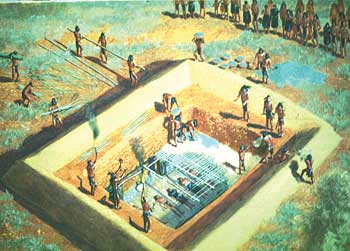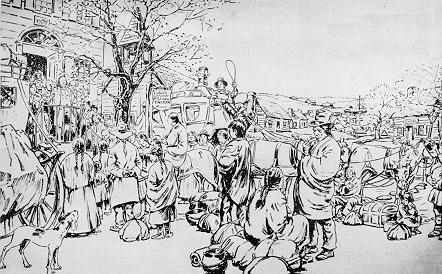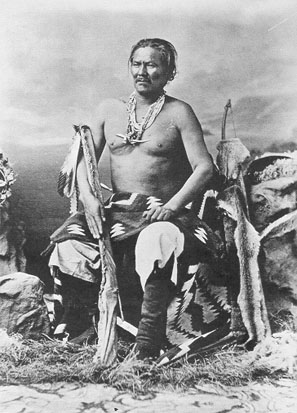|
August
23, 1732:
|
Today marks the beginning of a peace conference held in Philadelphia
with the local Indians. Attending the meeting are several
Iroquois Chiefs, including Onondaga Chief Shikellamy.
|
|
|
August
24, 1835:
|
The United States signs a treaty (7 Stat.,
474.) with the Choctaw, Comanche, Creek (Muscogee), Cherokee,
Osage, Quapaw, Seneca and Witchita at Camp Holmes "on
the eastern border of the Grand Prairie, near the Canadian
River." Governor Montfort Stokes, Brigadier-General M.
Arbuckle, represent the U. S. Many Indians sign the treaty.
|
|
|
August
25, 1737:
|
A agreement ise signed by Thomas Penn and
Munsee Chiefs Manawkyhickon and Nutimus. Teeshacomin and Lappawinzoe
also sign. The agreement recognizes an old deed made in 1686.
The agreement calls for Indian lands to be sold along the
Delaware River for the distance that a man can walk in a day
and a half. This is called the "Walking Purchase"
and is performed on September 19, 1737.
|
|
|

An
early Caddo burial scene, as envisioned by mural artist Nola
Davis of Texas Parks and Wildlife Department. An upcoming
theme exhibit on Texas Beyond History will look at the remarkable
East Texas Caddo culture from its earliest beginnings to the
contemporary Caddo Nation.
|
|
August
26, 1842:
|
The Caddoes sign a treaty in Texas. They
agree to visit other tribes and try to convince them to also
sign treaties with Texas.
|
|
|
August
27, 1878:
|
Captain James Egan, and Troop K, Second
Cavalry, are following a group of Bannocks, who have been
stealing livestock along the Madison River. Near Henry's Lake,
Captain Egan's forces skirmish with the Bannocks, and recover
fifty-six head of livestock. The escaping Bannocks are starting
to follow the trail taken by the Nez Perce, last year.
|
|
|
August
28, 1833:
|
Assiniboines attack Piegan Indians at Fort
McKensie.
|
|
|

DEPARTURE
FROM THE BROTHERTON RESERVATION
The Brotherton Reservation was in Burlington County
near the present town of Indian Mills. Thus was one
of the earliest reservations in the country and probably
the first to be so constituted. It was established in
1758 and the following year nearly one hundred Indian
families were placed there in the hope they would become
self-supporting. The experiment failed and after many
mishaps the Indians moved to New Stockbridge, New York,
in 1802. The reservation was sold; part of the proceeds
was used to transport them to their new home and part
was invested for them in United States securities.
|
|
|
August
29, 1758:
|
The First State Indian reservation, in
Brotherton New Jersey, is established. It is primarily for
the Lenni Lenape.
|
|
|
August
30, 1645:
|
A peace treaty between the Dutch, led by
Willem Kieft, and several local tribes is signed at Fort Orange,
in modern Albany. This treaty concludes a protracted conflict
in the area.
|
|
|
August
31, 1666:
|
Mohawk Chief Agariata is attending a peace
conference in Quebec between the Iroquois and the French.
Governor Alexandre de Proville asks, during a dinner, if anyone
knew who killed his son a few months ago. Agariata brags that
he did it. The governor becomes so angry, he has Agariata
seized, and hung. This ends the peace process. Governor de
Proville leads French troops against the Mohawks, himself.
|
|
|

Manuelito, photographed in 1874.
|
|
Sept.
1, 1866:
|
Manuelito and twenty-three of his Navajo
followers surrender to the army at Fort Wingate.
|
|
|
Sept.
2, 1862:
|
Santee
Sioux engage in another fight in the Minnesota Uprising. Called
the "Birch Coulee Battle," it happens three miles
north of Morton, Minnesota. The Minnesota forces are led by
Major Joseph Brown. The Sioux are led by Big Eagle, Mankato,
and Red Legs. The army has been on a burial detail. At dawn,
the Sioux attack. The soldiers lose thirteen killed and forty-seven
wounded.
|
|
|
Sept.
3, 1680:
|
Don Antonio de Otermin is the Governor
of the province which contains modern Santa Fe, New Mexico.
The Pueblo Indians staged a revolt in August. Otermin enters
Isleta Pueblo and discovers it is abondoned.
|
|
|
Sept.
4, 1863:
|
The
Concow-Maidu had ancestral homes in the Butte County area
of northern California. Eventually, they were forced to move
to different lands. Many die or are killed along the way to
these distant, hostile places. One group of 461 Concows leaves
Chico, but only 277 will survive the two-week trip to Round
Valley.
|
|
|
Sept.
5, 1814:
|
Today sees the start of the two day battle
of Credit Island, near present day Davenport, Iowa. Major
Zackary Taylor, and 334 American soldiers are making their
way up the Mississippi River attacking British positions with
considerable success. They encounter a force of 1000 Indians
and British. The allied army forces Taylor to withdraw to
safety in Saint Louis.
|
|
|
|
|
|
|



